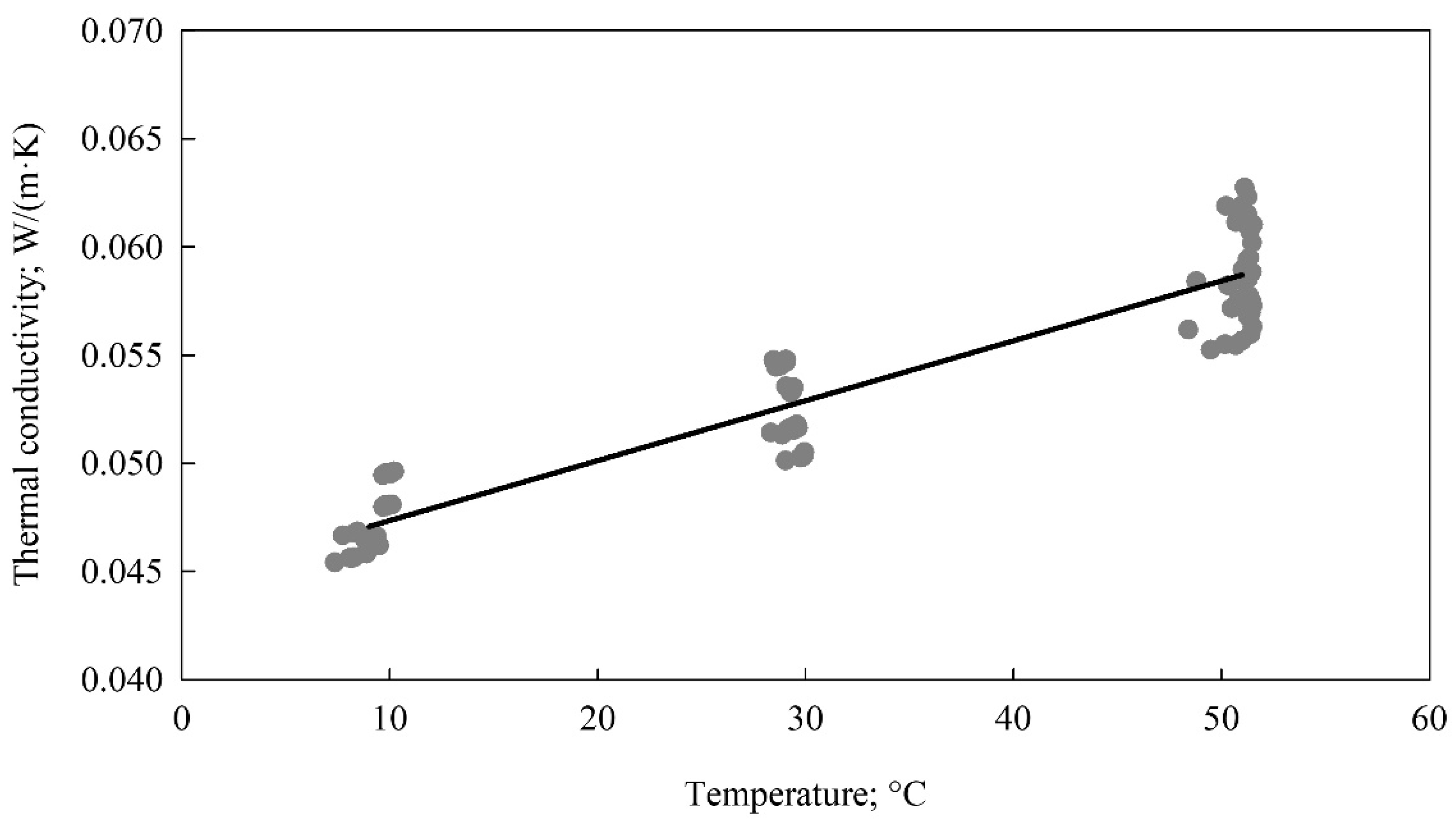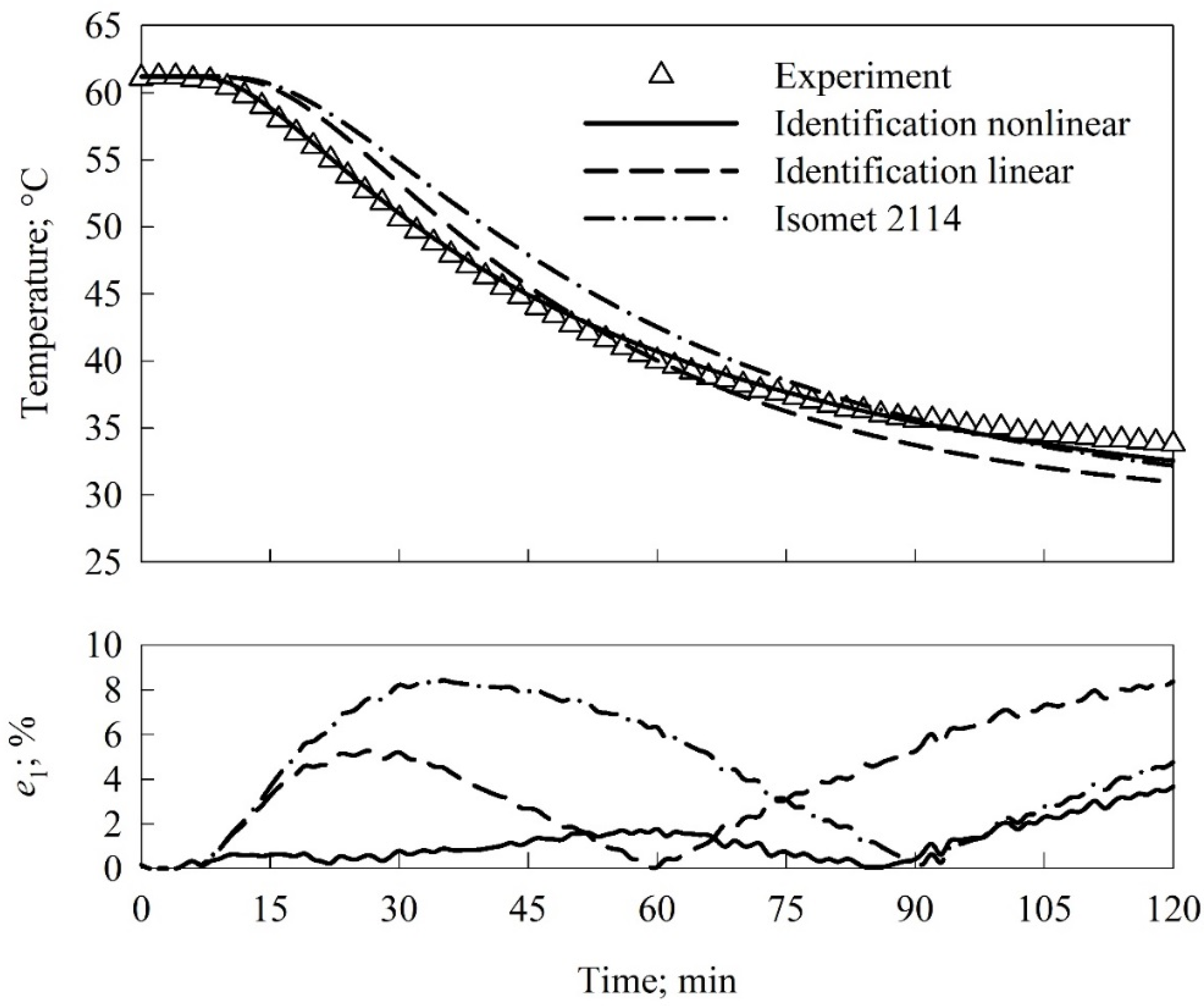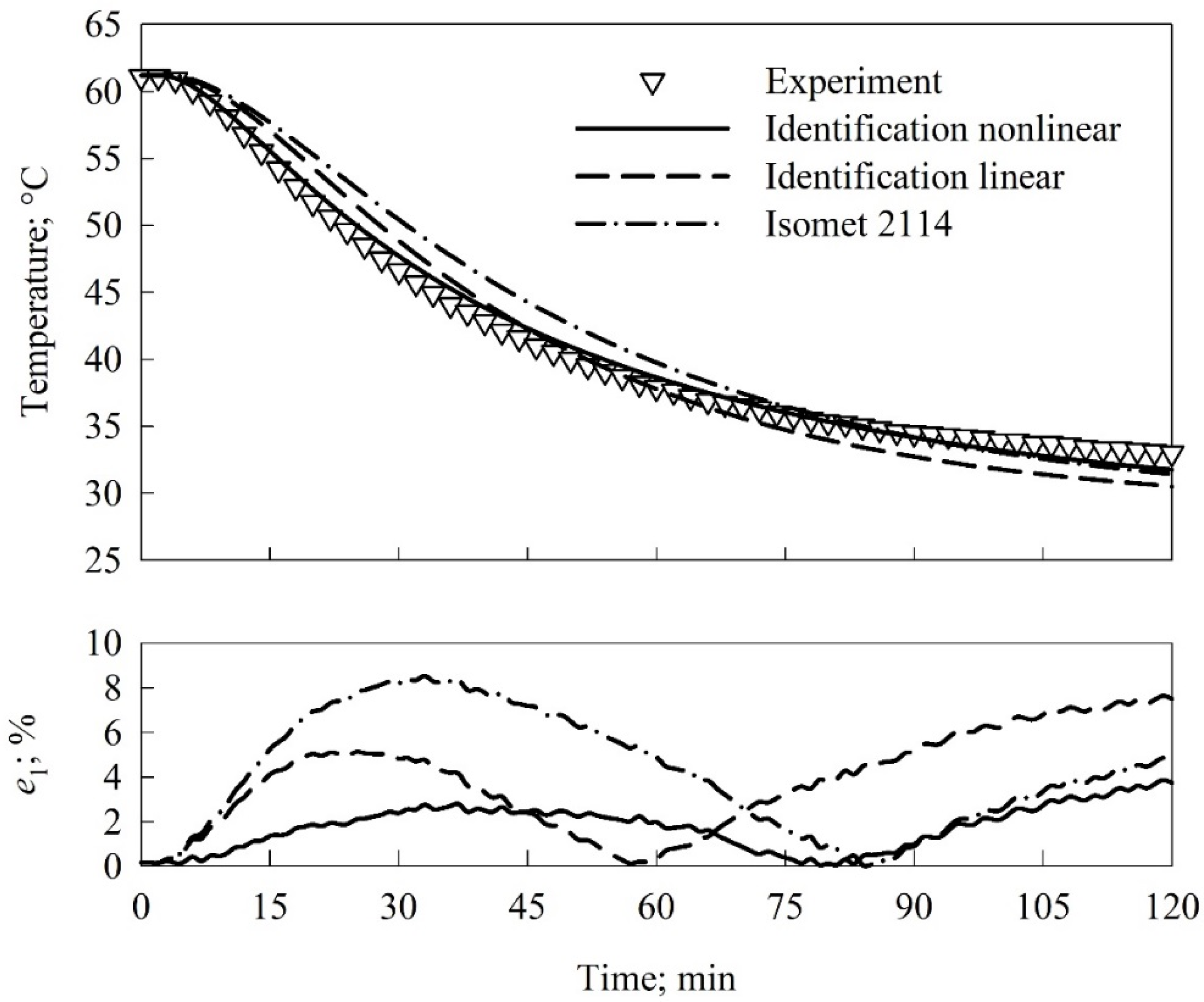Estimation of Thermal Properties of Straw-Based Insulating Panels
Abstract
:1. Introduction
2. Materials and Methods
2.1. Insulating Panels
2.2. Specific Heat and Bulk Density Determination
2.3. Thermal Conductivity Determination with the Transient Method (Isomet 2114)
2.4. Thermal Conductivity Identification with the Inverse Modeling
3. Results
3.1. Density and Specific Heat
3.2. Thermal Conductivity Measured with Isomet 2114
3.3. Thermal Conductivity Identified with the Inverse Method
3.4. Thermal Properties Validation
4. Conclusions
- The water calorimeter was effectively used for determining the specific heat of straw-based insulating panels. The exploited calorimeter guaranteed high repeatability and accuracy of specific heat measurements, i.e., the standard deviation of the measurements was lower than 8 J/(kg·K). The investigated insulating panels were characterized by high values of the specific heat of over 1600 J/(kg·K), which resulted in finding volumetric specific heat capacity of ca. 0.35 MJ/(m3·K) despite a low density of ca. 210 kg/m3.
- The design of the experiment for measuring the thermal conductivity with Isomet 2114 instrument enabled accounting for temperature influence on the property. The discrete values of the thermal conductivity were parametrized with the linear function. The obtained results of the thermal conductivity were similar to the findings obtained for the insulating composites made of hemp shiv and insulating panels manufactured from barley straw and olive tree wastes.
- The two options of the inverse identification were highly effective in determining the thermal conductivity. However, the identification option assuming the linear dependence of the thermal conductivity on temperature revealed higher accuracy as compared to the option which postulated that there is no influence of temperature on the identified property. It clearly shows the importance of more accurate modeling by accounting for the temperature influence on the thermal conductivity.
- The validation procedure enabled quantification of the credibility of the applied experimental methods for determining thermal properties of straw-based insulating panels. It was clearly depicted that accurate modeling of heat transfer in the insulating panels is possible when using the specific heat as determined by the calorimetric method together with the thermal conductivity identified with the inverse modeling or measured by the applied instrument. However, it was presented that higher accuracy is obtained when using the identified thermal conductivity accounting for the linear dependency on temperature (the local in time relative error e1 did not exceed 2% and the global in time relative error e2 varied from ca. 3% to 5% for this option of the identification).
Author Contributions
Funding
Institutional Review Board Statement
Informed Consent Statement
Data Availability Statement
Conflicts of Interest
References
- Kumar, D.; Alam, M.; Zou, P.X.W.; Sanjayan, J.G.; Memon, R.A. Comparative analysis of building insulation material properties and performance. Renew. Sustain. Energy Rev. 2020, 131, 110038. [Google Scholar] [CrossRef]
- Segovia, F.; Blanchet, P.; Auclair, N.; Essoua, G.G.E. Thermo-mechanical properties of wood fiber insulation board using a bio-based adhesive as a binder. Buildings 2020, 10, 152. [Google Scholar] [CrossRef]
- Cintura, E.; Nunes, L.; Esteves, B.; Faria, P. Agro-industrial wastes as building insulation materials: A review and challenges for Euro-Mediterranean countries. Ind. Crop. Prod. 2021, 171, 113833. [Google Scholar] [CrossRef]
- Zhao, J.; Li, S. Life cycle cost assessment and multi-criteria decision analysis of environment-friendly building insulation materials–A review. Energy Build. 2022, 254, 111582. [Google Scholar] [CrossRef]
- Liuzzi, S.; Rubino, C.; Martellotta, F.; Stefanizzi, P.; Casavola, C.; Pappaletter, G. Characterization of biomass-based materials for building applications: The case of straw and olive tree waste. Ind. Crop. Prod. 2020, 147, 112229. [Google Scholar] [CrossRef]
- Domínguez-Robles, J.; Tarrés, Q.; Alcalà, M.; El Mansouri, N.-E.; Rodríguez, A.; Mutjé, P.; Delgado-Aquilar, M. Development of high–performance binderless fiberboards from wheat straw residue. Const. Build. Mater. 2020, 232, 117247. [Google Scholar] [CrossRef]
- Pędzik, M.; Janiszewska, D.; Rogoziński, T. Alternative lignocellulosic raw materials in particleboard production: A review. Ind. Crop. Prod. 2021, 174, 114162. [Google Scholar] [CrossRef]
- Abu-Jdayil, B.; Mourad, A.-H.; Hittini, W.; Hassan, M.; Hameedi, S. Traditional, state-of-the-art and renewable thermal building insulation materials: An overview. Const. Build. Mater. 2019, 214, 709–735. [Google Scholar] [CrossRef]
- Czajkowski, Ł.; Wojcieszak, D.; Olek, W.; Przybył, J. Thermal properties of fractions of corn stover. Const. Build. Mater. 2019, 210, 709–712. [Google Scholar] [CrossRef]
- Bouasker, M.; Belayachi, N.; Hoxha, D.; Al-Mukhtar, M. Physical characterization of natural straw fibers as aggregates for construction materials applications. Materials 2014, 7, 3034–3038. [Google Scholar] [CrossRef] [PubMed] [Green Version]
- Dupont, C.; Chirac, R.; Gauthier, G.; Toche, F. Heat capacity measurements of various biomass types and pyrolysis residues. Fuel 2014, 115, 644–651. [Google Scholar] [CrossRef]
- Hýsek, Š.; Neuberger, P.; Sikora, A.; Schönfelder, O.; Ditommaso, G. Waste utilization: Insulation panel from recycled polyurethane particles and wheat husks. Materials 2019, 12, 3075. [Google Scholar] [CrossRef] [PubMed] [Green Version]
- Palumbo, M.; Lacasta, A.M.; Holcroft, N.; Shea, A.; Walker, P. Determination of hygrothermal parameters of experimental and commercial bio-based insulation materials. Const. Build. Mater. 2016, 124, 269–275. [Google Scholar] [CrossRef] [Green Version]
- Xu, J.; Sugawara, R.; Widyorini, R.; Han, G.; Kawai, S. Manufacture and properties of low-density binderless particleboard from kenaf core. J. Wood Sci. 2004, 50, 62–67. [Google Scholar] [CrossRef]
- Soroushian, P.; Hassan, M. Evaluation of cement–bonded strawboard against alternative cement–based siding products. Const. Build. Mater. 2012, 34, 77–82. [Google Scholar] [CrossRef]
- Karade, S.R. Cement–bonded composites from lignocellulosic wastes. Const. Build. Mater. 2010, 24, 1323–1330. [Google Scholar] [CrossRef]
- Lourëat, M.; Ayouz, M.; Perré, P. Heat and moisture diffusion in spruce and wood panels computed from 3-D morphologies using the Lattice Boltzmann method. Int. J. Therm. Sci. 2018, 130, 471–483. [Google Scholar] [CrossRef] [Green Version]
- Hammerschmidt, U. Guarded hot-plate (GHP) method: Uncertainty assessment. Int. J. Thermophys. 2002, 23, 1551–1570. [Google Scholar] [CrossRef]
- Çengel, Y.A.; Ghajar, A.J. Heat and Mass Transfer: Fundamentals & Applications, 5th ed.; McGraw-Hill: New York, NY, USA, 2015. [Google Scholar]
- Domínguez-Muñoz, F.; Anderson, B.; Cejudo-López, J.M.; Carrillo-Andrés, A. Uncertainty in the thermal conductivity of insulation materials. Energy Build. 2010, 42, 2159–2168. [Google Scholar] [CrossRef] [Green Version]
- Csanády, D.; Fenyvesi, O.; Nagy, B. Heat transfer in straw-based thermal insulating materials. Materials 2021, 14, 4408. [Google Scholar] [CrossRef]
- Ferroukhi, M.Y.; Abahri, K.; Belarbi, R.; Limam, K.; Nouviaire, A. Experimental validation of coupled heat, air and moisture transfer modeling in multilayer building components. Heat Mass Transf. 2016, 52, 2257–2269. [Google Scholar] [CrossRef]
- Palacios, A.; Cong, L.; Navarro, M.E.; Ding, Y.; Barreneche, C. Thermal conductivity measurements techniques for characterizing thermal energy storage materials—A review. Renew. Sust. Energy Rev. 2019, 108, 32–52. [Google Scholar] [CrossRef]
- Czajkowski, Ł.; Olek, W.; Weres, J.; Guzenda, R. Thermal properties of wood-based panels: Specific heat determination. Wood Sci. Technol. 2016, 50, 537–545. [Google Scholar] [CrossRef] [Green Version]
- Weres, J.; Olek, W. Inverse finite element analysis of technological processes of heat and mass transport in agricultural and forest products. Dry. Technol. 2005, 23, 1737–1750. [Google Scholar] [CrossRef]
- Weres, J.; Olek, W.; Kujawa, S. Comparison of optimization algorithms for inverse FEA of heat and mass transport in biomaterials. J. Theor. Appl. Mech. 2009, 47, 701–716. [Google Scholar]
- Weres, J.; Olek, W.; Guzenda, R. Identification of mathematical model coefficients in the analysis of the heat and mass transport in wood. Dry. Technol. 2000, 18, 1697–1708. [Google Scholar] [CrossRef]
- Huang, C.-H.; Yan, J.-Y. An inverse problem in simultaneously measuring temperature-dependent thermal conductivity and heat capacity. Int. J. Heat Mass Trans. 1995, 38, 3433–3441. [Google Scholar] [CrossRef]
- Kim, S.K.; Jung, B.S.; Kim, H.J.; Lee, W.I. Inverse estimation of thermophysical properties for anisotropic composite. Exp. Therm. Fluid Sci. 2003, 27, 697–704. [Google Scholar] [CrossRef]
- Borges, V.L.; Sousa, P.F.B.; Fernandes, A.P.; Guimarães, G. Thermophysical properties identification in the frequency domain. In Thermal Measurements and Inverse Techniques; Orlande, H.R.B., Fudym, O., Maillet, D., Cotta, R.M., Eds.; CRC Press: Boca Raton, FL, USA, 2011; pp. 617–653. [Google Scholar]
- Bezjak, M.; Zvizdić, D. Dynamic measurements of the thermal conductivity of insulators. Int. J. Thermophys. 2011, 32, 1467–1478. [Google Scholar] [CrossRef]
- Hussain, A.; Calabria-Holley, J.; Lawrence, M.; Jiang, Y. Hygrothermal and mechanical characterisation of novel hemp shiv based thermal insulation composites. Const. Build. Mater. 2019, 212, 561–568. [Google Scholar] [CrossRef]
- Olek, W.; Weres, J.; Guzenda, R. Effects of thermal conductivity data on accuracy of modeling heat transfer in wood. Holzforschung 2003, 57, 317–325. [Google Scholar] [CrossRef]




| Coordinates | Thermocouple Location | ||||||
|---|---|---|---|---|---|---|---|
| #1 | #2 | #3 | #4 | #5 | #6 | #7 | |
| x1 | 50 | 50 | 50 | 50 | 50 | 75 | 100 |
| x2 | 50 | 25 | 0 | 50 | 50 | 50 | 50 |
| x3 | 50 | 50 | 50 | 75 | 100 | 50 | 50 |
| Observation | Sample Initial Temperature tis; °C | Initial Equilibrium Temperature of the Calorimetric System te; °C | Increase of Temperature ΔT; K | Specific Heat c; J/(kg·K) | Density ρ; kg/m3 | Volumetric Specific Heat Capacity c·ρ;MJ/(m3·K) |
|---|---|---|---|---|---|---|
| #1 | 98.0 | 18.56 | 1.41 | 1672 | 210 | 0.3511 |
| #2 | 99.6 | 18.41 | 1.46 | 1668 | 203 | 0.3386 |
| #3 | 98.2 | 17.65 | 1.46 | 1682 | 211 | 0.3549 |
| #4 | 99.4 | 18.02 | 1.46 | 1683 | 212 | 0.3568 |
| #5 | 99.2 | 18.34 | 1.46 | 1686 | 218 | 0.3675 |
| Mean value | - | - | - | 1678 | 211 | 0.3538 |
| Thermocouple Number | Option of Validation | ||
|---|---|---|---|
| Nonlinear Identification | Linear Identification | Isomet 2114 Measurements | |
| #1 | 1.21 | 4.09 | 5.19 |
| #2 | 1.42 | 3.73 | 3.65 |
| #4 | 1.88 | 4.05 | 5.10 |
| #6 | 1.98 | 3.71 | 2.78 |
Publisher’s Note: MDPI stays neutral with regard to jurisdictional claims in published maps and institutional affiliations. |
© 2022 by the authors. Licensee MDPI, Basel, Switzerland. This article is an open access article distributed under the terms and conditions of the Creative Commons Attribution (CC BY) license (https://creativecommons.org/licenses/by/4.0/).
Share and Cite
Czajkowski, Ł.; Kocewicz, R.; Weres, J.; Olek, W. Estimation of Thermal Properties of Straw-Based Insulating Panels. Materials 2022, 15, 1073. https://doi.org/10.3390/ma15031073
Czajkowski Ł, Kocewicz R, Weres J, Olek W. Estimation of Thermal Properties of Straw-Based Insulating Panels. Materials. 2022; 15(3):1073. https://doi.org/10.3390/ma15031073
Chicago/Turabian StyleCzajkowski, Łukasz, Robert Kocewicz, Jerzy Weres, and Wiesław Olek. 2022. "Estimation of Thermal Properties of Straw-Based Insulating Panels" Materials 15, no. 3: 1073. https://doi.org/10.3390/ma15031073
APA StyleCzajkowski, Ł., Kocewicz, R., Weres, J., & Olek, W. (2022). Estimation of Thermal Properties of Straw-Based Insulating Panels. Materials, 15(3), 1073. https://doi.org/10.3390/ma15031073






